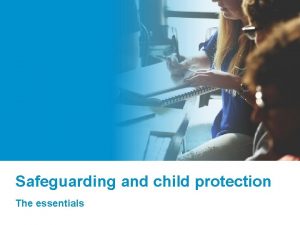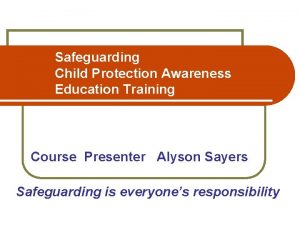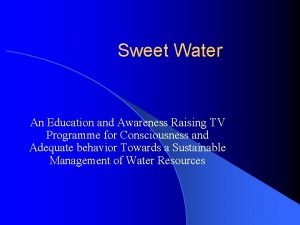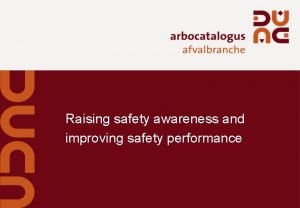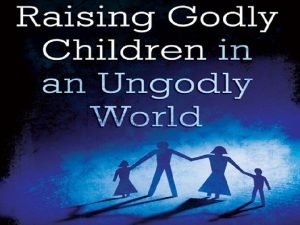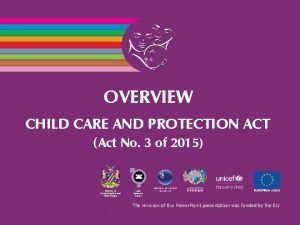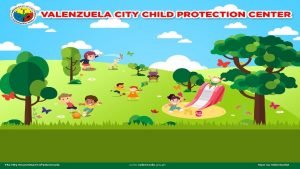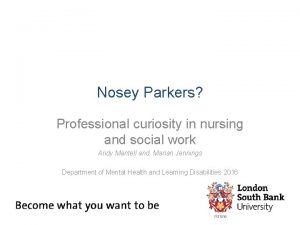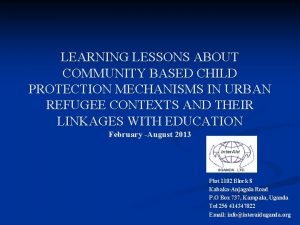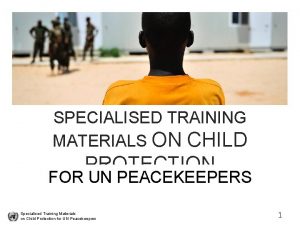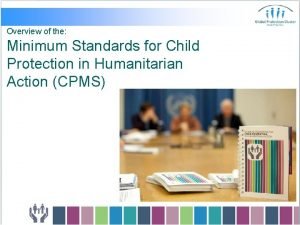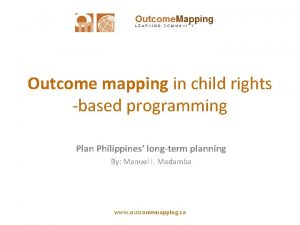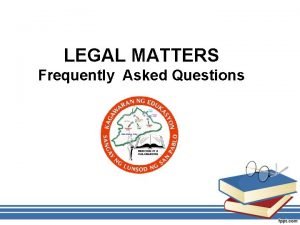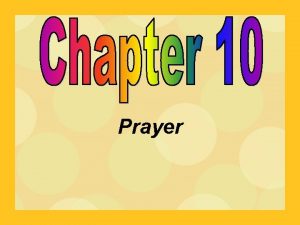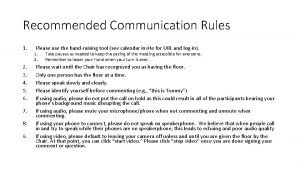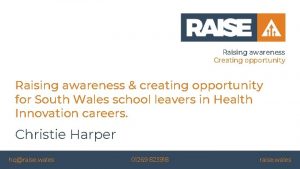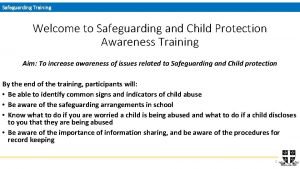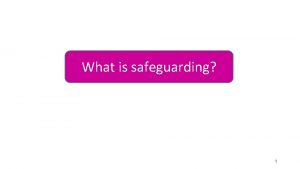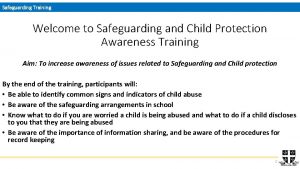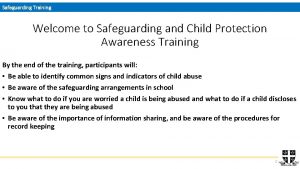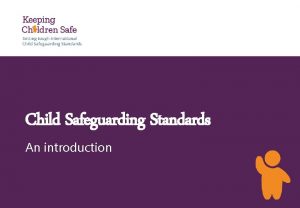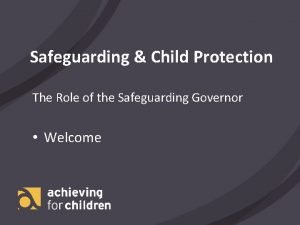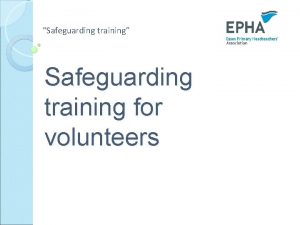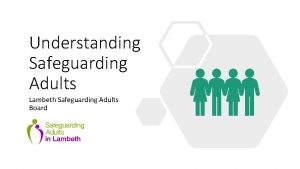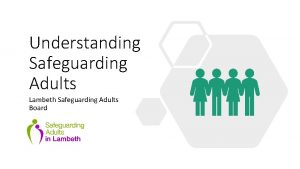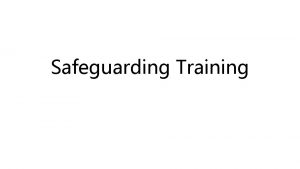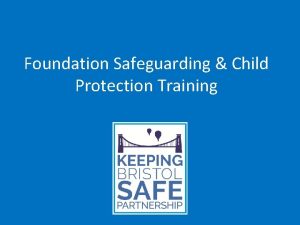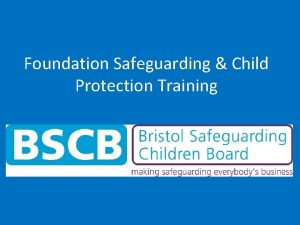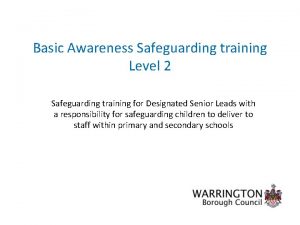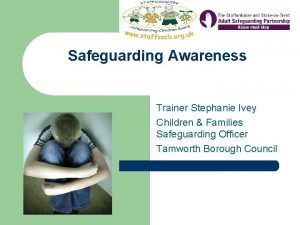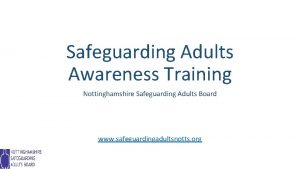Safeguarding and child protection awareness raising and update































- Slides: 31

Safeguarding and child protection: awareness raising and update September 2019

Session Objectives The session will cover: the current guidance available to staff and governors in relation to safeguarding the new Essex multi-agency safeguarding arrangements (MASA) how to identify the signs and indicators of child abuse how to respond to child welfare concerns the safeguarding and child protection procedures in your school

Children/ young people with a child protection plan by categories of abuse Category of abuse Neglect 2014 20, 970 2015 2016 2017 2018 22, 230 23, 150 24, 590 25, 820 Physical abuse 4, 760 4, 350 4, 200 3, 950 4, 120 Sexual abuse 2, 210 2, 340 2, 370 2, 260 2, 180 Emotional abuse Multiple 15, 860 4, 500 Total 48, 300 16, 660 17, 770 17, 280 18, 860 4, 110 2, 810 3, 010 2, 820 49, 690 50, 310 51, 080 53, 790

A child centred and coordinated approach to safeguarding Safeguarding and promoting the welfare of children is everyone’s responsibility. Everyone who comes into contact with children and their families and carers has a role to play in safeguarding children. In order to fulfil this responsibility effectively, all professionals should make sure their approach is child-centred. This means that they should consider, at all times, what is in the best interests of the child. Keeping Children Safe in Education 2019

Safeguarding defined Protecting children from maltreatment Preventing impairment of children’s health or development Ensuring that children are growing up in circumstances consistent with the provision of safe and effective care; and Taking action to enable all children to have the best outcomes. Working Together to Safeguard Children 2019 5

The role of school and college staff School staff are particularly important as they are in a position to identify concerns early, provide help for children, and prevent concerns escalating. Holistic safeguarding in schools has three strands: Creating a safe place for children and young people to share their concerns and experiences Creating a space where children feel safe to learn Looking after the well-being of staff 6

What you need to know All staff should be aware of systems within their school which support safeguarding and these should be explained to them as part of staff induction. This should include the following: Child protection policy Behaviour policy Staff behaviour policy (code of conduct) Safeguarding response to children who go missing from education (At least) Part 1 and Annex A of Keeping Children Safe in Education The role and identity of the designated safeguarding lead (and any deputy DSLs) 7

Current guidance Working together to safeguard children 2018 Keeping children safe in education – statutory guidance for schools and colleges – September 2019 Inspecting safeguarding in maintained schools and academies – Ofsted September 2019 What to do if you’re worried a child is being abused – March 2015 Child Sexual Exploitation guidance – Df. E February 2017 Sexual violence and sexual harassment between children in schools and colleges Df. E May 2018 8

Current guidance Guidance for safer working practice for those working with children and young people in education settings May 2019 SET Procedures –May 2019 Information sharing – advice for practitioners – July 2018 PREVENT Duty – Df. E guidance July 2015 Effective support for children and families in Essex – July 2017 ESCB Multi-Agency Safeguarding Arrangements 2019 -20 9

Multi-Agency Safeguarding Arrangements in Essex New government guidance set out in Working Together 2018 has resulted in changes to multi-agency safeguarding arrangements in England. There are now three Statutory Partners in Essex who are jointly responsible by law for the partnership arrangements for keeping children safe: Essex County Council Essex Police 5 Clinical Commissioning Groups covering the county of Essex The Statutory Partners have identified relevant agencies which are legally required to cooperate with the new safeguarding arrangements – this includes all schools and colleges. The new partnership arrangements will continue to be referred to as the Essex Safeguarding Children Board (ESCB) keeping its name and identity as it is a well-known and trusted brand. 10

Keeping Children Safe in Education 11 This is statutory guidance from the Department for Education. Schools and colleges in England must have regard to it when carrying out their duties to safeguard and promote the welfare of children. For the purposes of this guidance children includes everyone under the age of 18.

Keeping Children Safe in Education 2019 – key changes Types of abuse Upskirting is now a form of peer-on-peer abuse There is new information on serious violent crime (29 -30) Part 2 - the management of safeguarding Multi-agency working (68 -75) Reference to new relationships, health and sex education (89) Part 3 - safer recruitment Maintained schools should carry out section 128 checks on their governors Associate members don't need to have an enhanced DBS check Annex C - online safety There's now a link to new Df. E guidance on teaching online safety in schools. 12

What is child abuse? Child abuse is when a child is intentionally harmed by an adult or another child – it can be over a period of time but can also be a one-off action. It can be physical, sexual or emotional and it can happen in person or online. It can also be a lack of love, care and attention – this is neglect. 13

Categories of abuse There are four main categories of abuse and neglect: Physical abuse Emotional abuse Sexual abuse Neglect Knowing what to look for is vital to the early identification of abuse and neglect. 14

Some of the other safeguarding issues described in KCSi. E 2019 Bullying, including cyberbullying Children and the court system Children missing education, home or care Children with family members in prison Child sexual exploitation Child criminal exploitation – including County Lines Domestic abuse Drugs Fabricated or induced illness Gangs and youth violence Gender-based violence Homelessness Mental health Online safety Peer on peer abuse Preventing radicalisation Private fostering Relationship abuse Sexual violence and sexual harassment between children and schools and colleges Sexting So-called “honour-based” violence Female genital mutilation Forced Marriage Trafficking Upskirting

Topical issues 16 Peer on peer abuse The Prevent Duty Female Genital Mutilation (FGM) Child Sexual Exploitation (CSE) On-line safety County lines

Staff responsibilities in relation to Prevent Schools have a vital role to play in protecting pupils from the risks of extremism and radicalisation. Keeping children safe from risks posed by terrorist exploitation of social media should be approached in the same way as safeguarding children from any other online abuse. If an adult in school has a concern for the safety of a specific young person at risk of radicalisation, they should follow the school’s safeguarding procedures, including discussing the concern with the Designated Safeguarding Lead and, if deemed necessary, with children’s social care. Staff can also contact the local police force or dial 101 (the non-emergency number). The local authority or police might suggest a referral to the “Channel” programme, a voluntary Government programme which aims to safeguard children and adults from being drawn into terrorist activity. The Education Lead for PREVENT in Essex is Jo Barclay, Safeguarding Adviser to Schools.

Staff responsibilities in relation to FGM Teachers must personally report to the police cases where they discover that an act of FGM appears to have been carried out. Unless the teacher has a good reason not to, they should also still consider and discuss any such case with the school or college’s designated safeguarding lead and involve children’s social care as appropriate. The duty does not apply in relation to at risk or suspected cases (i. e. where the teacher does not discover that an act of FGM appears to have been carried out, either through disclosure by the victim or visual evidence) or in cases where the woman is 18 or over. In these cases, teachers should follow local safeguarding procedures.

Child Sexual Exploitation (CSE) 19 Child sexual exploitation is a form of child sexual abuse. It occurs where an individual or group takes advantage of an imbalance of power to coerce, manipulate or deceive a child or young person under the age of 18 into sexual activity (a) in exchange for something the victim needs or wants, and/or (b) for the financial advantage or increased status of the perpetrator or facilitator. The victim may have been sexually exploited even if the sexual activity appears consensual. Child sexual exploitation does not always involve physical contact; it can also occur through the use of technology.

Online abuse and bullying 20 Online abuse is any type of abuse that happens on the web, whether through social networks, playing online games or using mobile phones. Children and young people may experience cyberbullying, grooming, sexual abuse, sexual exploitation or emotional abuse. Children can feel like there is no escape from online abuse – abusers can contact them at any time of the day or night, the abuse can come into safe places like their bedrooms, and images and videos can be stored and shared with other people. https: //www. nspcc. org. uk/preventingabuse/keeping-children-safe/

County Lines County lines is a term used to describe gangs and organised criminal networks involved in exporting illegal drugs into one or more importing areas within the UK, using dedicated mobile phone lines or other form of “deal line”. They are likely to exploit children and vulnerable adults to move and store the drugs and money and they will often use coercion, intimidation, violence (including sexual violence) and weapons. Gangs recruit and use children and young people to move drugs and money for them. Children as young as 11 years old are recruited, often using social media. They are exploited and forced to carry drugs between locations, usually on trains or coaches. They may also be forced to sell drugs to local users. 21

Who is vulnerable? Gangs are known to target vulnerable children and adults; factors that heighten that vulnerability are: having prior experience of neglect, physical and/or sexual abuse lack of a safe/stable home environment, now or in the past social isolation or social difficulties economic vulnerability homelessness or insecure accommodation status connections with other people involved in gangs having a physical or learning disability having mental health or substance misuse issues being in care (particularly those in residential care and those with interrupted care histories being excluded from mainstream education, in particular attending a Pupil Referral Unit 22

2 minute discussion 23 What signs should you look out for that might suggest that a child or young person is, or is at risk of, being involved with county lines or criminal exploitation? How should you respond if you think or know that a child or young person is being exploited.

What to do if you are concerned 24 Anyone working with a vulnerable child or young person who they think may be at risk of county lines and/or criminal exploitation should follow their local safeguarding guidance and share this information with local authority social care services. If you believe a person is at immediate risk of harm you should contact the police. As a member of staff in school, your first step will be to discuss your concerns with your designated safeguarding lead. The DSL has the responsibility for linking in with social services and the police.

Refer your concerns Concerns about a child’s welfare can vary greatly in terms of their nature and seriousness, how they have been identified and over what duration they have arisen. If you have concerns about a child, you should ask for help. Follow your child protection policy and speak to the Designated Safeguarding Lead. 25

Managing a disclosure Children experiencing distress or abuse may seek to ‘tell’ in school, often because this is the place where they feel most safe, secure and listened to. It is not unusual for them to choose members of staff seen to be on the periphery of the staff team such as midday supervisors, caretakers or classroom support staff because they may be perceived as having less authority, more time and be less intimidating. 26

So, what do I do if a child asks to talk to me about a problem? 27 Listen to the child - let them do the talking and try not to say things for them Do not promise them confidentiality After the child has told you the problem, try to record their exact words You need to record enough detail to support your concerns that they have a serious issue/are at risk, but stick to basic facts After the meeting, complete the concern form and report to the DSL

Referral processes in your school 28 You should record, in writing, all concerns and discussions about a child’s welfare, the decisions made and the reasons for those decisions. Safeguarding forms and record keeping at your school. Never leave any situation for a few days to allow you or the child to ‘think about it’ – the child could be at risk. Act immediately.

What should you do if you think that a concern you have raised has not been followed up?

All staff and volunteers should feel able to raise concerns about poor or unsafe practice and potential failures in the school or college’s safeguarding regime and know that such concerns will be taken seriously by the senior leadership team. Appropriate whistleblowing procedures, which are suitably reflected in staff training and staff behaviour policies, should be in place for such concerns to be raised with the school’s senior leadership team. The NSPCC whistleblowing helpline is available for staff who do not feel able to raise concerns regarding child protection failures internally. Staff can call 0800 0285 – line is available from 8: 00 am to 8: 00 pm, Monday to Friday or email: help@nspcc. org. uk

And finally… What will you do differently following this training? Is there anything you need to follow up on? 31
 Safeguarding and child protection the essentials
Safeguarding and child protection the essentials Child protection awareness training
Child protection awareness training Awareness raising tv spot
Awareness raising tv spot Raising safety awareness
Raising safety awareness What is an alternative of log based recovery
What is an alternative of log based recovery Raising a godly child in an ungodly world
Raising a godly child in an ungodly world Child safeguarding standards
Child safeguarding standards Privacy awareness and hipaa privacy training cvs answers
Privacy awareness and hipaa privacy training cvs answers Children's rights and responsibilities posters
Children's rights and responsibilities posters Child protection and toy safety act
Child protection and toy safety act Child care and protection act 3 of 2015
Child care and protection act 3 of 2015 Courage child protection
Courage child protection Types of child protection
Types of child protection Child marriage definition
Child marriage definition Child protection case management tools
Child protection case management tools Types of child protection
Types of child protection Professional curiosity in social work
Professional curiosity in social work Community based child protection mechanisms
Community based child protection mechanisms Child protection training materials
Child protection training materials Child protection minimum standards
Child protection minimum standards Child protection committee in schools
Child protection committee in schools Child protection policy
Child protection policy Child protection reform amendment act 2017
Child protection reform amendment act 2017 Prayer is the raising of one's heart and mind to god
Prayer is the raising of one's heart and mind to god Parts of extension ladder firefighter
Parts of extension ladder firefighter Left child right sibling tree
Left child right sibling tree Statue of votive figures
Statue of votive figures Raising of the mary rose
Raising of the mary rose Describe preindustrial societies of agriculturalists.
Describe preindustrial societies of agriculturalists. Tohru raising the floor
Tohru raising the floor Raising agents in food
Raising agents in food Nadar raising photography to the height of art
Nadar raising photography to the height of art
